According to Statista, in 2021 about 27% of internet users were blocking advertising on their internet-connected devices. That percentage is expected to grow in 2022. That means that publishers need to familiarize themselves with adblock technology and adblock walls and how they affect your revenue. Many users don't even know that they have an ad blocker enabled. Often, the browser they use has the ad blocker turned on automatically when they upgrade their software.
Jump to:
- What is an adblock wall?
- Why do people use adblockers?
- How can publishers recover the lost revenue to adblockers?
- How effective are adblock walls?
- Does every visitor see an adblock wall message?
- Can adblock walls offer benefits to visitors?
- How can publishers measure their adblock wall?
- What is the difference between an adblock wall, a paywall, and a registration wall?
- Do adblock walls result in less revenue than ad reinsertion?
What is an anti-adblock wall?
An anti-adblock wall is marketing automation to recover lost revenues from site visitors using adblock tech to block ads. The adblock wall will engage visitors and ask them to allow ads to be shown on that particular site. Or, the visitor may be offered options to support the site such as a paid subscription, or a temporary ad-free pass in exchange for newsletter signup.
With so many people using ad blocker technology when they visit a publisher's website, visitors can miss out on promotions, specials, and advertising that they actually want. In addition, your promotions and advertising drive revenues for your business. These revenues can be earned through referrals, clicks, or direct purchases placed from an ad. This lost revenue can sorely affect your bottom line, reducing both awareness and direct sales that you earn through your ads and landing pages.
Anti-adblock walls are typically only viewable to visitors who are actively blocking ads. With Admiral's engage layer, many other targeting and frequency settings can be applied and tweaked across a scale of revenue recovery, conversion rate, and visitor experience.
Why do people use adblockers?
A recent Admiral poll of over 14,000 adblock users shared their primary reasons for using adblock technology. General avoidance of ads across browsing, and blocking annoying or intrusive ads, were the top reasons stated. Admiral maintains the world's largest survey panel of cross-vendor adblock users.
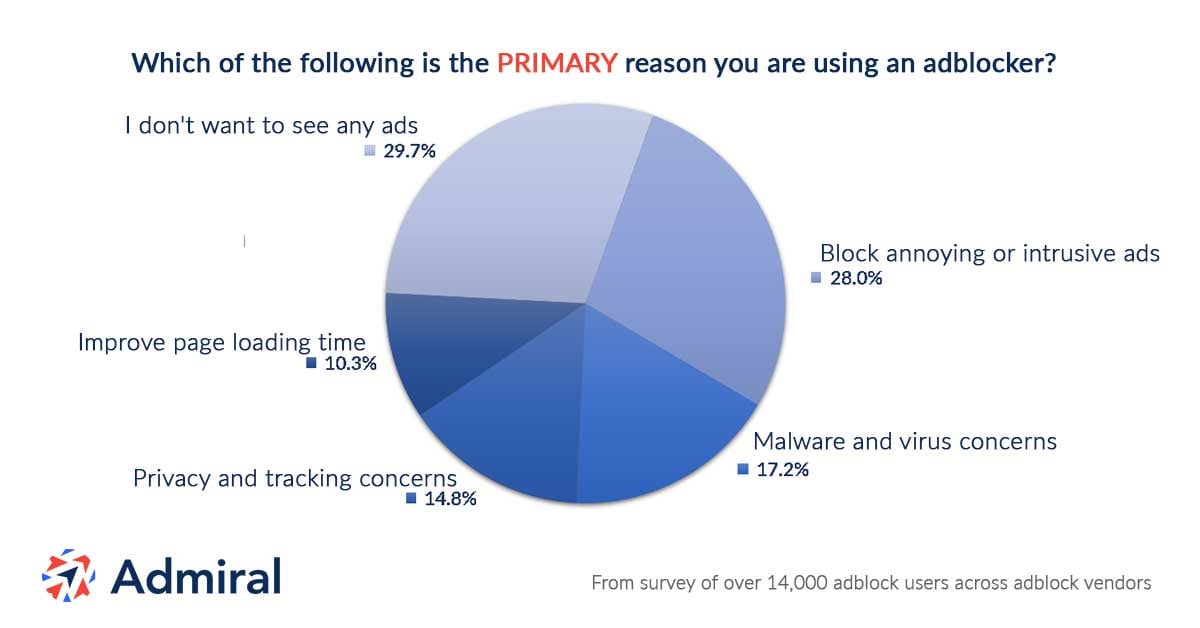
How can publishers recover the revenue lost to adblockers?
The best solution for recovering revenue lost because of adblock technology is by engaging adblock users to solicit their cooperation with sites they enjoy. There are many variants of the anti-adblock wall request, which may include offering the visitor a choice of multiple ways they can support the publishers.
Multiple methods of recovering adblock revenue have been tested for months in head-to-head studies on top publishers. In multiple tests, solutions that engage the visitors to turn off their adblockers have resulted in 5x-9x greater revenue returns on an RPM basis than other methods.
Read the adblock recovery head-to-head case study.
/Case%20Studies/Case-study_Admiral_vs_Alternative_revenue-recovery.png?width=1200&height=628&name=Case-study_Admiral_vs_Alternative_revenue-recovery.png)
An anti-adblock wall is a software solution that provides publishers a means to recapture revenue lost to adblockers. The adblock wall engages the visitor if their adblocker is turned on and asks them to allow ads from the site they are currently on; they can even keep their adblocker installed for the rest of the internet. Adblockers, if not allow-listed, not only cost publishers revenue, but can break, disrupt, or impact websites and the overall website visitor experience.
Adblock technology is problematic for all publisher sites and content creators. Ad revenue is the main source of income for free content sites. Globally, adblock usage is costing publishers over $40 billion annually.
How effective are anti-adblock walls?
The numbers are clear, Adblock walls are the most effective revenue recovery approach for adblock users.
Not all adblock technology is alike. Depending on which adblocker you're talking about, it may block all recognized ads, just pop-up ads, auto-play videos, or disrupt coding for cookies, tracking, or other scripts used to collect data on your website visitors.
Admiral's anti-adblock wall works using a combination of solutions because each type of adblock technology affects your website differently. This robust combination of recovery options includes:
- Unlock/Allowlist visitors - This works by engaging your website visitors directly, asking their permission to "allowlist" your specific website, so that visitors experience your entire ad stack. This method results in an average of 3 - 4 times the CPM revenue as an average user.
- Adblock detection - Admiral maintains the technical expertise to detect the range of adblock extensions, even as they change constantly.
- Offering a value exchange - Admiral offers several ways to appeal to your users, like:
- Donations in return for access to content
- Ad-free content with an email newsletter signup
- Site registration or email subscription for ad-free content
- Temporary ad-free experiences, or paid digital subscriptions.
- Ad reinsertion - This solution offers ads that the adblock vendor okays, delivering a standard set of ads
- Robust controls for frequency and targeting - Message frequency, CTA skipping, page targeting, geo-targeting, metering, custom targeting, query parameters, and more.
You can learn more about these adblock wall solutions at Admiral's Ultimate Adblock Revenue Recovery Guide. Adoption of these adblock wall techniques can even result in better, sustainable relationships with your visitors.
Does every visitor see an anti-adblock wall message?
No. Visitors only see an adblock message if they have adblocking enabled on their device or browser, AND depending on the frequency and targeting settings for a publisher using anti-adblock recovery. Adblock usage worldwide is over 40% of internet users. A visitor relationship-driven solution such as Admiral's can provide many targeting options for publishers:
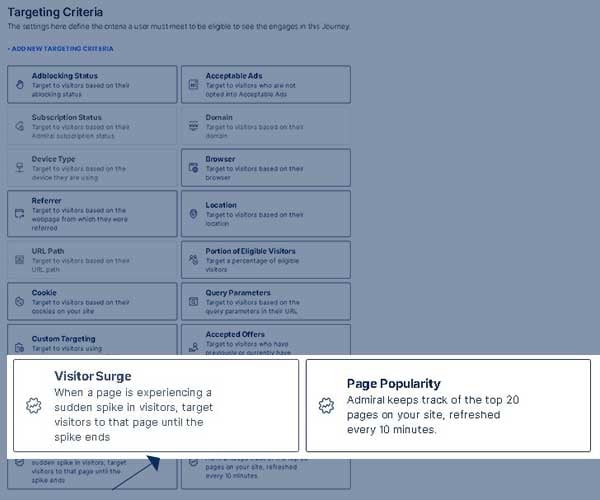
Can adblock walls offer benefits to visitors?
Yes. Depending on the type of adblock wall in use, visitors can receive benefits, including access to a free newsletter, subscription to valuable content, downloadable content, other free premium content, app downloads, early access or access to promotions or sales, and other benefits. And adblock walls support the sustainability of ad-funded quality content that visitors enjoy.
How can publishers measure their block-adblock wall?
You can start with Admiral's free adblock revenue analytics to see how your site is being impacted currently by different types of adblockers. Using adblock analytics you can accurately measure how your website is affected by adblock technology as well as the revenue you've lost and recovered, and the type of device used to access your content. You can measure:
- Lost revenue due to blocked ads
- Total blocked ad impressions or rate
- Site visits and page view statistics by adblock users
- Adblock usage by device, browser, OS, or location
- Any recovered adblock revenues
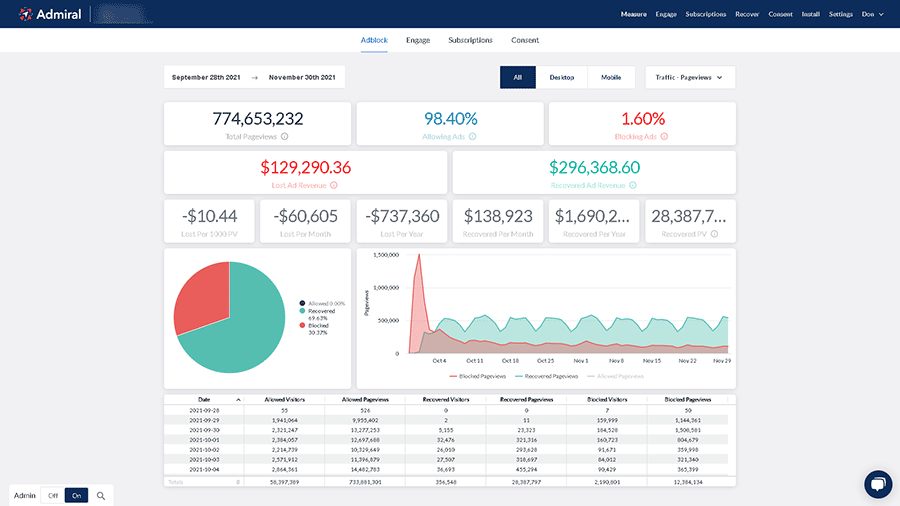
What is the difference between an adblock wall, a paywall, and a registration wall?
Paywalls, registration walls, and adblock walls are all methods to manage the access of visitors to content, either by requiring a free registration, a paid subscription, or supporting the site via ad views, donations, or other options presented to the visitor.
- Adblock wall - This software is installed by the publisher with an opt-in by the user. This gives users access to ads, content, downloads, and more when they visit a publisher's site.
- Paywall - The publisher installs this software and appears on a webpage when the user is required to buy a subscription to access the content. The subscription period and length of time is variable.
- Registration wall - The publisher installs this software and appears when the user needs to register in order to access the content.
Do adblock walls result in less revenue than ad reinsertion?
No, in fact, adblock walls drive greater engagement and revenue from visitors than ad reinsertion methods (Acceptable Ads). See the full-stack adblock engagement vs ad reinsertion case study. Adblock walls use a combination of revenue recovery methods. Using an intelligent block-adblock solution plus ad reinsertion will net more recovered revenue.
Here are 6 reasons a full-stack adblock recovery engagement approach is superior for publishers:
- outperforms ad reinsertion significantly on an RPM revenue basis,
- is overtly consent-based rather than assumed-consent,
- does not fund future attacks on publisher revenue, (the owners of Blockthrough and AAX also own Adblock, AdBlock Plus, and uBlock).
- leverages your full ad stack, not inventory limited by format, size, frequency,
- Is a consistent position for your DMCA access control rights, and
- is a more visitor and relationship-centric part of an overall VRM vision, which includes consent-based options to visitors at every step of the reader journey, including social, email, subscriptions, donations GDPR consent, and more.
Check out this webinar recording on next-level adblock recovery, including case study data on ad reinsertion vs full stack recovery.
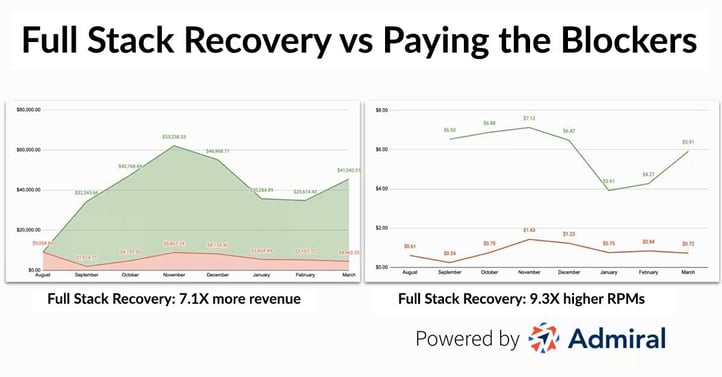
Why would ad reinsertion generate less revenue per pageview than an adblock wall?
Engagement-based adblock recovery uses a combination of permission-based methods to recover lost revenue. Adblock messaging can recover all ad units lost through adblocking software.
Ad reinsertion, using Acceptable Ads, only fills a subset of ad units, on a subset of pageviews, from a subset of adblockers that support Acceptable Ads. It is getting a fraction of a fraction of a fraction of the lost revenue. See image.
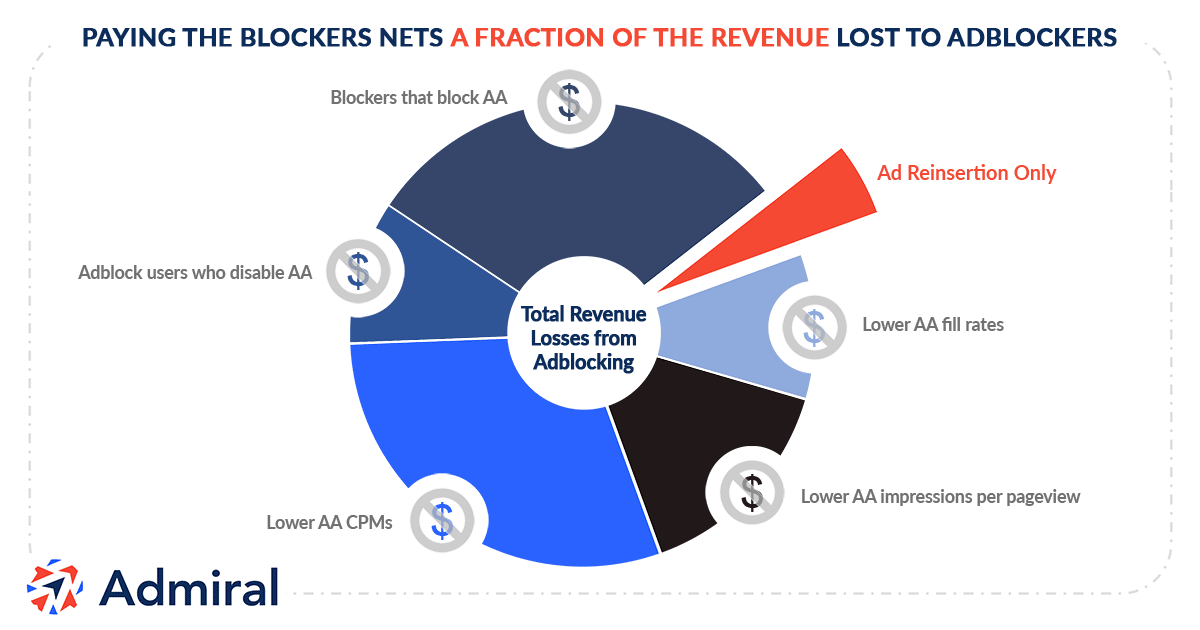
Can an adblock wall be used in combination with ad reinsertion?
An adblock wall and ad reinsertion can easily be used in combination. Admiral's adblock wall software uses several revenue recovery methods including ad reinsertion and allowlisting. Even if you are using adblock reinsertion managed by another third party, Admiral's full-stack engagement solution can be leveraged simultaneously, and you can track exactly how much revenue each approach is unlocking.
Admiral has helped major stack management partners leverage this solution across hundreds of publishers.
Find out how much revenue you can recover with Admiral.
Ask about the new AI-driven Surge Targeting, and how it can maximize conversions for adblock recovery.





